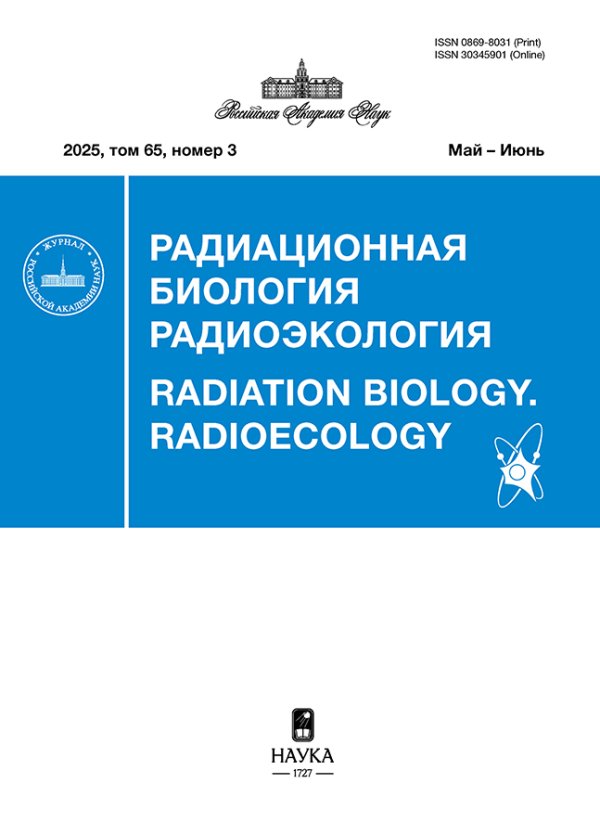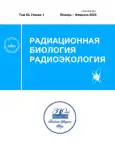On the nature of the interaction of radiationand non-radiation factors of space flight in neurobiological effects in their combined effect on animals in model experiments
- Authors: Shtemberg A.S.1, Perevezentsev A.A.1, Lebedeva-Georgievskaya K.B.1, Belyaeva A.G.1
-
Affiliations:
- Institute of Biomedical Problems, Russian Acadevie of Sciences
- Issue: Vol 65, No 1 (2025)
- Pages: 52–63
- Section: Space radiobiology
- URL: https://modernonco.orscience.ru/0869-8031/article/view/688226
- DOI: https://doi.org/10.31857/S0869803125010058
- EDN: https://elibrary.ru/KOLSIZ
- ID: 688226
Cite item
Abstract
Currently, sufficient experimental data have been obtained indicating significant violations of the functions of the central nervous system (CNS) at all levels of its organization caused by exposure to heavy ions in doses comparable to those potentially possible during a Martian mission. An extremely important and, at the same time, the least studied problem is the neurobiological effects of the combined action of ionizing radiation and non-radiative factors of spaceflight, in particular, the most important of them-microgravity. Analyzing the neurobiological effects of the interaction of simulated microgravity (ANS) and ionizing radiation, we found their complex nature: at all levels of the central nervous system organization (from molecular to integrative), both synergistic and antagonistic relationships were observed under the combined in fluence of these factors. The possibility of the antagonistic nature of the interaction of these PCF data was a very unexpected effect that requires further research. It can be concluded that the neurobiological effects of the interaction of ANS and ionizing radiation with their synchronous combined action are complex, which we called interference, by analogy with the physical phenomenon of interference, showing synergistic or antagonistic effects, or the appearance of new effects in relation to behavior, metabolism of monoamines and molecular mechanisms. It is possible that the manifestation of this kind of interaction may lead to the leveling of negative consequences from the effects of these factors.
Full Text
About the authors
Andrey S. Shtemberg
Institute of Biomedical Problems, Russian Acadevie of Sciences
Author for correspondence.
Email: andrei_shtemberg@mail.ru
ORCID iD: 0000-0001-8944-0296
Russian Federation, Moscow, Khoroshevskoe shosse 76A
Alexander A. Perevezentsev
Institute of Biomedical Problems, Russian Acadevie of Sciences
Email: perezx@me.com
ORCID iD: 0000-0001-6464-2887
Russian Federation, Moscow, Khoroshevskoe shosse 76A
Kseniya B. Lebedeva-Georgievskaya
Institute of Biomedical Problems, Russian Acadevie of Sciences
Email: kseniagb@gmail.com
ORCID iD: 0000-0002-4424-6358
Russian Federation, Moscow, Khoroshevskoe shosse 76A
Alexandra G. Belyaeva
Institute of Biomedical Problems, Russian Acadevie of Sciences
Email: yasya_bi@mail.ru
ORCID iD: 0000-0003-4980-6526
Russian Federation, Moscow, Khoroshevskoe shosse 76A
References
- Daunton N.D. Space neurosciences: A new frontier. Neurosci. Lett. 1987;(28):53.
- Григорьев А.И., Красавин Е.А., Островский М.А. К оценке риска биологического действия галактических тяжелых ионов в условиях межпланетного полета. Рос. физиол. журн. им. М.А. Сеченова. 2013;99(3):273–280. [Grigoriev A.I., Krasavin E.A., Ostrovsky M.A. To assess the risk of biological action of galactic heavy ions in the conditions of interplanetary flight. Sechenov Rossiyskiy Fisiologicheskiy Journal. 2013;99(3):273–280. (In Russ.)]
- Григорьев А.И., Красавин Е.А., Островский М.А. “К вопросу о “радиационном барьере” при пилотируемых межпланетных полетах. Вестник РАН. 2017;87(1):27–35. [Grigoriev A.I., Krasavin E.A., Ostrovsky M.A. “On the issue of the “radiation barrier” in manned interplanetary flights. Vestnik RAS. 2017;87(1):27–35. (In Russ.)]
- Rabin B.M., Joseph J.A., Shukitt-Hale B. Heavy particle irradiation, neurochemistry and behavior: threshold, dose-response curves and recovery of function. Advanc. Space Res. 2004;(33):1330–1333.
- Rabin B.M., Joseph J.A., Shukitt-Hale B. A longitudinal study of operant responding in rats irradiated when 2 months old. Radiat. Res. 2005; ( 64):552–555.
- Britten R.A., Davis L.K., Johnson A.M. et al. Low (2 cGy) doses of 1 GeV/u 56Fe-particle radiation loads to a persistent reduction in the spatial learning ability of rats. Radiat. Res. 2012;177(2): 146–151.
- Machida M., Lonart G., Britten R.A. Low (60 cGy) Doses of 56Fe HZE-Particle Radiation Lead to a Persistent Reduction in the Glutamatergic Readily Releasable Pool in Rat Hippocampal Synaptosomes. Radiat. Res. 2010; 174(5): 618–623.
- Chang P.Y., Doppalapudi R., Bakke J. et al. Biological impact of low dose-rate simulated solar particle event radiation in vivo. Radiat. Environ. Biophys. 2010;49(3):379–388.
- Khan S., Tariq M., Perrott J. et al. Distinctive microRNA expression signatures in proton-irradiated mice. Mol. Cell Biochem. 2013;382(3):225–235.
- Pecaut M.J., Haerich P., Zuccarelli C.N. et al. Behavioral consequences of radiation exposure to simulated space radiation in the C57Bl/6 mouse: open field, rotarod, and acoustic startle. Cognitive, Affective and Behavioral Neuroscience. 2002;2(4):329–340.
- Shtemberg A.S., Kokhan V.S., Matveeva M.I. et al. The impact of high-energy protons in Bragg peak on the behavior of rats and exchange of monoamines in some brain structures. Neurochem. J. 2015;9(1):66–72.
- Штемберг А.С. Проблемы экспериментального исследования комбинированного действия факторов космического полета на функции организма животных. Рос. физиол. журн. 2014;100(10): 1152–1168. [Shtemberg A.S. Problems of experimental investigation of the combined effect of space flight factors on animal body functions. Sechenov Rossiyskiy fisiologicheskiy Journal. 2014;100(10): 1152–1168. (In Russ.)]
- Murray R.H., McCally M. Combined environmental stresses. Bioastronautics data book. 2-nd ed. Wash. (DC): NASA, 1973. P. 881–914. (NASASP 3006).
- Лившиц Н.Н., Мейзеров E.С., Закирова P.M., Тихая В.А. Исследование действия вибрации, облучений и комплекса этих факторов на условные рефлексы и лабиринтные навыки в опытах на одних и тех же животных. Функции центральной нервной системы при комбинированном действии стресс-факторов. М.: Наука, 1973. P. 51–61. [Livshits N.N., Meyzerov.S., Zakirova P.M., Tikhaya V.A. Investigation of the effect of vibration, irradiationand the complex of these factors on conditioned reflexes and labyrinth skills in experiments on the same animals. The functions of the central nervous system under the combined action of stress factors. M.: Nauka, 1973. P. 51–61. (In Russ.)]
- Штемберг А.С. Комбинированное действие разных форм двигательной депривации и гамма-облучения на высшую нервную деятельность крыс. Авиакосмич. и экол. мед. 1997;31(2):38–43. [Shtemberg A.S. Aviakosmicheskaya i ekologicheskaya medicina. 1997;31(2):38–43. (In Russ.)]
- Штемберг А.С. Комбинированное действие гипокинезии и разных доз гамма-облучения на условнорефлекторную деятельность крыс. Авиакосм. и экол. мед. 1997;31(3):34–39. [Shtemberg A.S. The combined effect of hypokinesia and different doses of gamma radiationon the conditioned reflex activity of rats. Aviakosmicheskaya i ekologicheskaya medicina. 1997;31(3):34–39. (In Russ.)]
- Ushakov I.B., Shtemberg A.S., Krasavin E.A. et al. Effects of space radiation and combined impact of radiation and other spaceflight factors on CNS in model experiments on animals. Biol. Bull. Rev. 2019;9:93–104.
- Shtemberg A.S., Kudrin V.S., Klodt P.M. et al. The effects of antiorthostatic hypodynamia and overload on discriminant learning and monoamine exchange in the brain structures of mice. Neurochem. J. 2012;6(4):291–298.
- Kokhan V.S., Matveeva M.I., Bazyan A.S. et al. Combined effects of antiorthostatic suspension and ionizing radiation on the behaviour and neurotransmitters changes in different brain structures of rats. Behav. Brain Res. 2017;320:473–483.
- Kokhan V.S., Kudrin V.S., Shtemberg A.S. Serotonin and Noradrenaline Metabolism in the Brain of Rats under the Combined Action of Radiation and Hypogravity in a Ground-based Experiment. Neurochem. J. 2019;13(1):57–61.
- Kokhan V.S., Kudrin V.S., Shtemberg A.S. Serotonin and Noradrenaline Metabolism in the Brain of Rats under the Combined Action of Radiation and Hypogravity in a Ground-based. Neurochem. J. 2019;13(1):57–61.
- Kokhan V.S., Lebedeva-Georgievskaya K.B., KudrinV.S. et al. An investigation of the single and combined effects of hypogravity and ionizing radiation on brain monoamine metabolism and rats’ behavior. Life Sci. Space Res. 2019;20(1):12–19.
- Mao X.W., Nishiyama N.C., Pecaut M.J. et al. Simulated Microgravity and Low-Dose/Low-Dose-Rate Radiation Induces Oxidative Damage in the Mouse Brain. Radiat. Res. 2016. № 185. Р. 647–657.
- de OliveiraA.R., ReimerA.E., ReisF.M., BrandaoM.L. Conditioned fear response is modulated by a combined action of the hypothalamic-pituitary-adrenal axis and dopamine activity in the basolateral amygdala. Europ. Neuropsychopharmacol. 2013;(23):379–389.
- Kaenmaki M., Tammimaki A., Myohanen T. et al. Quantitative role of COMT in dopamine clearance in the prefrontal cortex of freely moving mice. J. Neurochem. 2011;(114):1745–1755.
- Karoum F., Chrapusta S.J., Egan M.F. 3-Methoxytyramine is the major metabolite of released dopamine in the rat frontal cortex: reassessment of the effects of antipsychotics on the dynamics of dopamine release and metabolism in the frontal cortex, nucleus accumbens, and striatum by a simple two pool model. J. Neurochem. 1994;(63):972–979.
- Clark K.L., Noudoost B. The role of prefrontal catecholamines in attention and working memory. Front. Neural Circuits. 2014. № 8. Р. 33.
- Puig M.V., Gulledge A.T. Serotonin and prefrontal cortex function: neurons, networks, and circuits. Mol. Neurobiol. 2011;(44):449–464.
Supplementary files



















